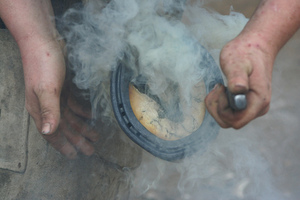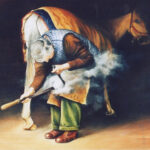Navicular disease is more accurately described as “navicular syndrome.” It is a soundness problem that affects horses, generally ones with hooves that are smaller than is proportional to their body weights. Navicular disease occurs almost exclusively on the horse’s front feet, and is generally described as the inflammation of the navicular bone in the hoof.
Navicular disease so far cannot be cured, but there are several things you can do to help treat your horse and keep them sound.
Corrective Shoeing
Corrective Shoeing is a popular way of treating navicular disease. This method requires a shoe that has been designed to lift the heel of the horse to take the pressure off the navicular bone. Usually in this method a wedge pad is placed between the hoof and the metal shoe to provide a lift and thus lessen the pain from navicular disease.
I have tried this method with my horse and frankly didn’t see much improvement. It is important to remember, however, that some farriers are more knowledgeable than others on how to trim and shoe horses that suffer from navicular disease. If you want to treat navicular disease, be sure that you choose a farrier who understands and has experience with these horses.
Trimming
There are many people who say that leaving navicular horses barefoot is the best way to keep the pain at bay because the blood circulation helps in the hoof. I, for one, am a supporter of this theory. I saw a vast improvement in my navicular horse when the corrective shoes were removed and she was left barefoot.
To get the best of a simple trim for your horse, be sure to find a farrier who specially caters to horses with navicular disease. Trims are simple for any farrier, but one who understands the concept of navicular disease can often create a more effectively shaped hoof.
Medication
There are basically two medications that have been found to effectively treat horses with navicular disease. Used in conjunction on a daily basis, I have found these medications to be very helpful.
The first medication is called isoxuprine, and is a vasodilator. Its purpose is to open the vessels in the hoof to allow more blood flow. This is necessary for helping keep the hoof healthy and less constrained from the degeneration or inflammation of the bone from navicular disease.
The second medication is an anti-inflammatory drug by the name of phenylbutazone. Dubbed “Bute” on a daily basis, this is a basic drug along with isoxuprine that your veterinarian will prescribe to your horse with navicular disease.
Prognosis
Navicular disease is a progressive disease, meaning it will only get worse with time. All horses that suffer from navicular disease must at some point or another have their workload lessened. It is not advised that you continue heavy and fast riding, and riding up steep hills.
This will put strain on the horse with navicular disease. Even still, a horse with this syndrome that is properly treated can remain active and useful for many years depending on their age, condition, and workload. In the end, it will be necessary to allow this horse to retire to the pasture for the rest of their days.



